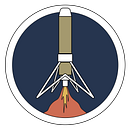Propulsive Landers @ Georgia Tech: Revolutionizing Student Rocketry with Powered Descent, One Step at a Time

Our team talks a lot about propulsive landing — it’s even in our club’s name. But what is propulsive landing, really? In simple terms, it’s a landing technique where a vehicle uses its engines to control descent, allowing it to slow down and land precisely on target. Unlike parachutes or other methods that rely on external forces to slow a vehicle down, propulsive landing lets us steer and decelerate using controlled engine thrust, making it ideal for accurate landings, even in tough conditions.
So… what makes us different? Typical rocketry clubs tend to focus on pushing altitude limits. For many, the goal is to reach the Kármán line — the boundary of space, 100 kilometers above Earth. For us, it’s about control, precision, and repeatable success. We’re working on a system that operates like a lunar lander, or any terrestrial lander for that matter, only on a much smaller and less complicated scale.
While our primary goal over the next year or two is to become the first student team in the world to achieve VTOL and hovering of a hybrid rocket, our vision extends far beyond that.
Below is a list of some iconic terrestrial vehicles that the US have sent to other planets from 1966 to present:
- Surveyor Program (1966–1968): “Surveyor 1, the first of a series of seven robotic spacecraft sent to the moon to gather data in preparation for NASA’s Apollo missions, was the first spacecraft to make a true soft landing on the moon. As such, it was one of the great successes of NASA’s early lunar and interplanetary program.” (“Surveyor 1”)
- Viking Program (1975–1976): “NASA’s Viking Project found a place in history when it became the first U.S. mission to land a spacecraft safely on the surface of Mars and return images of the surface. Two identical spacecraft, each consisting of a lander and an orbiter, were built. Each orbiter-lander pair flew together and entered Mars orbit; the landers then separated and descended to the planet’s surface.” (“Viking Project — NASA Science”)
- Curiosity Rover (2011): “Part of NASA’s Mars Science Laboratory mission, at the time of launch, Curiosity was the largest and most capable rover ever sent to Mars at that time.” (“Curiosity (MSL) — NASA Science”)
- Perseverance Rover (2021): “NASA’s Perseverance rover has been exploring the surface of Mars since landing in February 2021. The rover has made discoveries about the planet’s volcanic history, climate, surface, interior, habitability, and the role of water in Jezero Crater.” (“Perseverance”)
As you can imagine, landing on another planet is no easy feat. Each planetary body presents its own unique challenges, and engineers must design systems to endure varying environmental conditions, gravitational pulls, and atmospheric compositions. The iconic examples above all use some variation of propulsive descent to bring themselves to a stop — and this exact principle of controlled descent and precision is at the heart of our mission as we strive to bring similar innovations to student rocketry.

As a team, we do not plan to stop once VTOL and hovering have been completed. After the 50-meter hop, we will steadily increase the profile altitude to 2 kilometers. Past the 2-kilometer milestone, we will begin refining and altering our landing approach until we can eventually perform the same G-FOLD (Guidance for Fuel Optimal Large Diverts) algorithm — [stay tuned for an article on exactly that] — that is being explored for future space missions by NASA and Astrobotic.
Eventually, our goal is to develop a terrestrial lander that can serve as a testbed for complex guidance, navigation, and control algorithms, enabling low turnovers and rapid prototyping for advanced testing. Clearly, this is easier said than done — but we’re ready for whatever lies ahead, and we invite you to join us on this journey.
With that being said, we would like to thank all of our sponsors who make our work possible: Dassault Systèmes, Bolt Depot, PCBWAY, and Ebyte. If you’re interested in more of our work, tune in on our social media pages! Instagram, Flickr, and Website.
References
“Curiosity (MSL) — NASA Science.” NASA Science, 2024, science.nasa.gov/mission/msl-curiosity/.
“Perseverance.” NASA Science, 2024, science.nasa.gov/mission/mars-2020-perseverance/science/.
“Surveyor 1.” Jet Propulsion Laboratory — NASA, 2016, www.jpl.nasa.gov/missions/surveyor-1/.
“Viking Project — NASA Science.” NASA Science, 2024, science.nasa.gov/mission/viking/.
